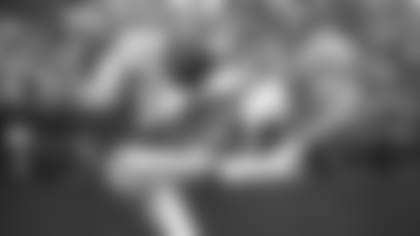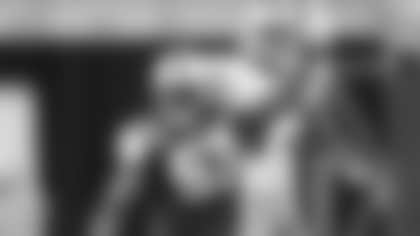
Duane Carrell didn't exactly have stability on his side during his football career. What the punter did have, however, was perseverance.
With his vagabond gridiron journey beginning as a walk-on at Florida State.
"I think I was the first person to come to Florida State just strictly as a kicking specialist. Everybody else came playing another position and kicking was a sideline with them," Carrell said.
"I kind of helped break the mold on that. And I think just going through the experience, I grew up an awful lot, learned how to act around the other players. I felt like I knew how to act once I got into pro camps."
Carrell would see his fair share of pro camps in the NFL and elsewhere. Undrafted, his first stop was in Washington in 1972.
"I knew I wasn't going to make it just because I knew (head coach) George Allen's attitude toward rookies. But it was the only place that would give me a tryout. I figured, 'Hey, I'm just going to go and see how I do. If I'm not good enough ability-wise, I can accept that and go on with my life,'" Carrell said.
"I was there for two weeks and thought I did well. In fact, I was punting and placekicking. The only field goal they let me try in a scrimmage, I made, and then I was gone the next day.
"But they said, 'Hey, we'd like you to go and play for Hagerstown,' which was in the Seaboard Football League. And I'll tell you, when I first went there, it was like culture shock. They said, 'The practice field is behind the Knights of Columbus hall out on the highway north of town.' There was one light up on the field. There was one set of goalposts and right behind it was a cornfield. And everybody was dressing for practice out of the back of their car. I was like, 'Oh, my God, is this really happening?'
"So I played for them and actually had a good time doing it. Talentwise, I was really the best punter/placekicker in the league. It was just kind of fun to go out there and not have the pressure on you."
The pressure-free Carrell would then find a new place to play when the World Football League was founded in 1974.
"I kind of had an in to the Jacksonville team," he said. "One of my former college coaches was the player personnel director. So starting off brand-new, I didn't have a veteran to beat out. I got there and got the experience and it kind of set the stage for me."
After playing in both the Seaboard and World Football Leagues, Carrell stepped onto centerstage in 1974 as a member of the Dallas Cowboys. In 1975, he was with the Los Angeles Rams.
"I went into (the 1976) training camp and can't say my season with the Rams was the greatest," Carrell laughed. "I was released after the first preseason game and was making some calls, and talked to (Jets special teams coach) Joe Gardi. They were playing a preseason game in Houston, and so I did a quick tryout in the Astrodome before the game.
"Joe said, 'I don't think you're quite what we want.' Two weeks later, he called again, and I played in the last preseason game that they had in Pittsburgh, and had a good game. So I had the job after that."
Calling Texas Stadium home while with the Cowboys and the Coliseum home while with the Rams, the reputation of Carrell's new NFL home in New York preceded itself.
"I was apprehensive about Shea Stadium because you heard all these horror stories about the wind and everything. And yet, I didn't find it that bad," Carrell said. "I think I actually had a better average at Shea than I did away from Shea. The winds swirled in there, but it wasn't like straight in your face. You could kind of deal with the wind."
Carrell also had to deal with a part of the game which he was unfamiliar with.
"I got to hold for placekicks and I'd never done that before in my life," Carrell said. "I was holding for Pat Leahy, and in the first game we played in Shea that year against Buffalo, we came down tied 14-all in the last minute and they sent us out for a 30-something yard field goal. I think Pat was worried about me, but I got the ball down and he put it through. I was probably the happiest guy on the field."
Carrell totaled 81 punts for 3,218 yards, a 39.7 average, during the 1976 campaign while the Jets compiled a 3-11 record under Lou Holtz and Mike Holovak. Walt Michaels became New York's new head coach in 1977, and Carrell sensed he'd likely be following Holtz and Holovak out of town.
"I could sort of tell from the beginning that Walt wasn't really all that keen on me. And then in our second game, against the Colts playing in the Meadowlands, I dropped a snap and fell on it on the 1-yard line. They scored on the next play. I was shown the door after that, and can't say I blamed him," Carrell laughed.
"I had kind of decided before the year that that was going to be my last season. It was tough on my wife, me taking off and going to a new place and then her having to pick up and start a house. I thought I'd finish out with the Jets and call it a career."
Carrell continued. "I really enjoyed the Jets. Except for Joe Namath and a couple other guys, I think we were all a bunch of no-names to a big extent. So the guys had a bit more closeness to them.
"And the Jets had a nice practice facility at Hofstra, and were the first team I played for where the office was at the practice field. So you got to know the people. (The NFL's first female scout) Connie Nicholas (Carberg) was there and I got to know her and all the other folks. It was a nice experience playing in New York. I have a lot of good memories."
Carrell and his wife, Gloria, make their home in Springfield, Illinois and have three adult sons: Todd, Tony, and Drew; and two grandchildren. He works as a sales rep for Johnson Press of America.
"We do the printing and mailing of magazines, and I've been with them for 20 years," said Carrell, 71. "I've got to have something to make me get up in the morning and kind of organize my day around. I'm not one of those who can play golf all the time and just do nothing in retirement. So I'm working. I figure if I hit the point where I get tired of it, I can stop. But right now, I still enjoy the challenge of it."














